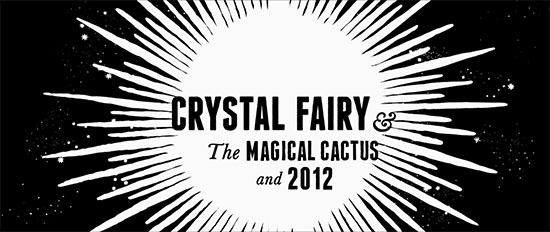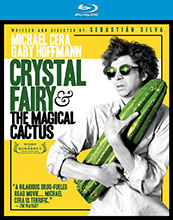
 BUY FROM AMAZON: CLICK HERE!
BUY FROM AMAZON: CLICK HERE!
MSRP $29.98
RATED NR
STUDIO MPI Home Video
RUNNING TIME 99 Minutes
SPECIAL FEATURES
• Behind the Scenes Featurette
• Trailer
The Pitch
Somebody made a really funny movie about that weird hippie chick you met at a party that one time.
The Humans
Michael Cera, Gaby Hoffman, The Silva Brothers
The Nutshell
During a road trip through Chile, boorish American expatriate Jamie (Michael Cera) and three Chilean brothers plan to set off in search of the prized San Pedro cactus and its promise of unrivaled hallucinations. But during a night’s drunken stupor Jamie invites free-spirited fellow American Crystal Fairy (Gaby Hoffmann) along on their psychedelic-driven journey, and before long Crystal’s devil-may-care attitude gives them more of an adventure than any of them had bargained for.

“Dear Earth mother, please grow gluten-free wheat. That is all.”
The Lowdown
Films like Crystal Fairy & The Magical Cactus shouldn’t exist. We see this all the time in studio pictures, particularly sequels: they are thrown together hastily, the script isn’t complete, but they shoot it anyway. In most cases, these “fuck-it-we’re-making-a-movie” productions result in a rudderless film, but in rare cases, this actually works in service of the final product. Crystal Fairy is one such film. It shouldn’t have worked at all, yet by some small miracle, it does.
When Michael Cera met Chilean filmmaker Sebastián Silva, the two got along so well that Silva invited Cera down to Chile to make a film called Magic Magic, to which Cera enthusiastically agreed. Cera arrived in Chile, but Magic Magic had hit rough waters: they were still waiting on financing to come through. So instead of waiting around, they decided to just make another film in the meantime. This film would be based upon Silva’s own experiences of meeting a woman who called herself Crystal Fairy.
Playing the titular hippie-dippie weirdo is Gaby Hoffman, and her performance is nothing short of amazing. If you’ve seen her recent turn on HBO’s Girls, you know just how crazy Hoffman can get, how uncomfortable she can make an audience, and how she can transform that discomfort into comedy and empathy. The character is so extreme that it nearly spills over into caricature, but the reality is that many of you have met a Crystal Fairy, especially if you’ve spent any time in New York City, Los Angeles, or the Pacific Northwest. Hoffman lends a pathos and humanity to this manic pixie nightmare girl, and I truly believe the film would have collapsed without her.

An appropriate reaction to unshaved hippie shenanigans.
In near-perfect counterpoint to Crystal Fairy is Jamie, a fellow American whose snarky, snobbish attitude fills the room. His vocabulary is full of backhanded compliments and passive-agressive remarks. He’s an inconsiderate houseguest, the kind of guy who’d take a dump in your bathroom and not flush the whole thing. He’s on a pretentious Aldous Huxley-style quest to expand his mind with drugs, and considers himself a connoisseur of illicit substances. Above all, however, he’s a massive dweeb, and Cera finds a way to let us follow this dweeb without completely despising him. We’re expected, in a way, to be just as repulsed by Crystal Fairy’s zany behavior, body hair, and nudity as Jamie is. In a highly watchable way, the two balance each other out.
The film’s other three cactus-chasers are played by the director’s brothers: Juan Andrés, José, and Agustín. While it’s clear that they’re not accomplished actors, they fit perfectly, and their line deliveries are beautifully natural and real. Another contributing factor to the film’s realistic tone is that most of the dialogue was improvised by the actors, or suggested by the director just before the cameras began rolling. Scenes unfold in a believable manner, and the tone doesn’t shift, except when cleverly broken by the injection of artificial dread. Silva wants us to know that he’s building up to something, and playfully reminds us that we’re supposed to be saying “what the fuck?”. One moment that left me puzzled is a random jump scare, when the camera lingers on an object a bit too long for comfort, and then we see a sudden flash of the Pazuzu face from The Exorcist, accompanied by a loud stab of music. I won’t pretend to know exactly why Silva put it in the film (he claims it’s a nod to YouTube shock videos), but I think outright playfulness is the simplest answer.

Crude visual gags have never been simpler.
Shortly after Pazuzu shows up, we reach the film’s midpoint, when our troupe acquires the San Pedro cactus. Initially, my concern was that the film would lose steam after this point, because I was under the impression that finding the cactus would place us closer to the finish line. Luckily, the film’s second half, where the mescaline concoction is prepared and taken, doesn’t sag like I feared it might. In true hallucinogenic fashion, paranoia, isolation, and mistrust begin to seep in around the edges, keeping us invested until our odd quintet are surfing the mescaline high. Wisely, Silva doesn’t employ any traditional psychedelic imagery during the film’s tripping sequences, instead relying on sound design, music, and a bit of tasteful slow motion to portray Jamie’s anxiety and euphoria.
While I won’t tell you exactly what transpires after the mescaline trip, I will say that the film carries us through this journey to arrive in a more vulnerable place, and smacks us with a scene so raw and riveting that it risks losing audience members who expected something a bit more madcap. The film reminds us what complicated stories we all are, and we understand that Jamie has been seeing other people as peripheral characters in his own personal story, instead of seeing that they’re all just as deeply cracked and fucked up and nuanced as he is. Sebastian Silva calls this moment “the birth of compassion”, which is a perfect description. It’s a bold moral statement, one that evokes complex and troubling gender issues, taking a stab at the naïve misogyny of young men.

I don’t have a caption for this image, but if I did, you’ve have to read it in Ron Howard’s voice.
Just as important as its moral stance is the fact that this film shows us why you should just go make a movie. Grab a camera, a few friends, some family members, and make it happen. Something good may come of it. You could argue that this is a hipster film (whatever that means), and perhaps you’re right, but a large portion of the film feels like a critique of hipster culture, because our leads are extreme examples of what happened when counterculture hit the mainstream. Crystal Fairy, a funny and bizarre (and superior, I think) companion piece to the humorless, maddening Magic Magic, comes alive with an unpolished vibrance that is only found in spontaneity. I wish there were more films like it.
The Package
While color and black levels are rich in this transfer, the image has a fair amount of digital noise, especially during darker scenes. The noise is most likely due to Silva shooting only in natural light, creating a simple, underlit, but noisy image. I don’t mind the noise, but celluloid purists may find it offensive. The audio is a 5.1 DTS-HS Master Audio mix, and it’s not exactly showy or immersive. It does exactly what the audio in a comedy needs to do: make the dialogue pleasantly audible. The disc’s extras include a short behind-the-scenes featurette and the film’s trailer. The featurette is disappointingly brief, and the trailer is standard fare, but I’m let down by the lack of a commentary from Silva. I think a detailed description of the production process could have taught valuable lessons to today’s young filmmakers.
Rating: 




Out of a Possible 5 Stars